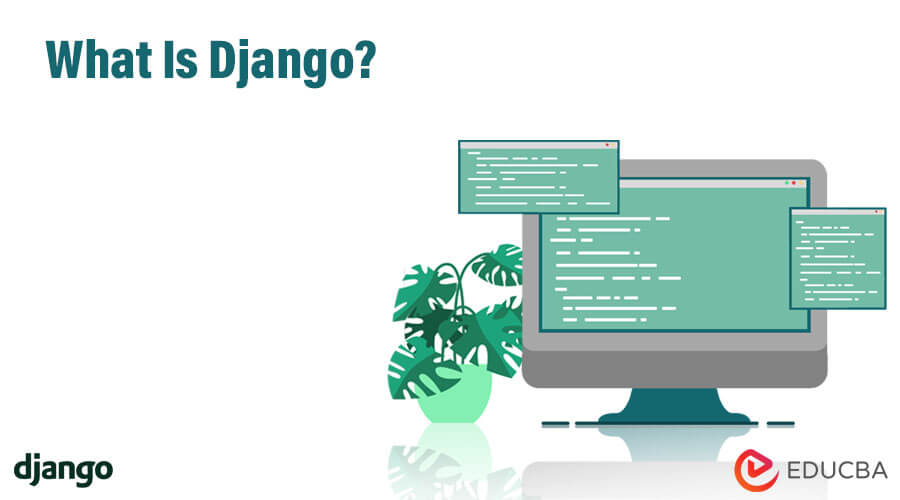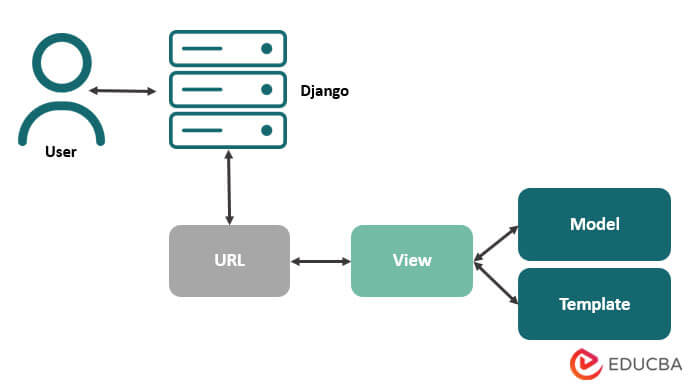Updated June 2, 2023
Introduction to Django
Django is a high-level Python framework for rapid web development. It follows the Model-Template-View (MTV) architecture, which makes it easier to develop complex, data-driven websites. It simplifies the web development process and helps developers with vast documentation to guide them through the website creation process. Developers find it easy to create web pages, as the framework provides tools to help neatly organize data and manage repositories with high relevance. It is a free and open-source framework.
Why Use Django Framework?
Django provides fast, simple, and rapid web development. It has extensive documentation and follows the principle DRY, i.e., Do not Repeat Yourself. Additionally, it comes with built-in Object Relational Mapping (ORM) support. A database can be updated through the command-line interface using the following command:
Code:
'python manage.py migrate'And migrations can be generated using the following:
Code:
'python manage.py makemigrations'Django’s MVT Pattern
Django utilizes MVT (Model-View-Template) instead of the traditional MVC (Model-View-Controller) pattern used for user interaction in application development. The template consists of HTML code with Django Template Language (DTL), and Django handles the controller code to manage interactions between the Model and View.
When a user sends a request, it acts as a controller by checking if the requested URL is available and maps it to the corresponding view. If the URL maps successfully, the view interacts with the model and generates a template, which returns to the user as a response. With its built-in default controller implementation, Django provides a solid foundation for many applications.
Installation and Setup
Installing it is relatively easy compared to other frameworks; however, it differs for operating systems. The latest version can be downloaded from their official website.
- It can be installed on Linux or Mac OS using the package manager or pip install.
- For Windows, if Python already exists on the system, one should check if Python Path is set for the system variable. Then extract and install it.
It supports many database engines and can be set as per requirements. It provides a built-in lightweight server for developing and testing the application.
Creating your Django Application
A Django project is a collection of settings that include database configuration, specific options, and default application-specific settings in the project.
Steps to create an application:
- Create a directory where you want to store your project.
- Navigate to the created directory using the command line interface and run the following command:
Code:
$ django-admin startproject my_appIf one looks at the directory, the following structure will be created:
mysite/
manage.py
mysite/
__init__.py
settings.py
urls.py
wsgi.py
- manage.py: Allows interaction with the Django project in different ways.
- __init__.py: Informs the Python interpreter that the directory must be considered a Python package. This file is mostly empty.
- settings.py: The configuration file.
- urls.py: Includes all URL declarations for the Django project and table of contents of the Django-powered site.
- wsgi.py: The entry point for WSGI-compatible web servers to serve the projects and deploy with WSGI.
If one wants to check whether the project is running, one can check it using the following command:
Code:
$ python manage.py runserverHow does Django make your Work Easy?
Django follows the “Simple is better than complex” approach, which is the Pythonic way of development. It is one of the Python packages stored inside the site-packages directory of the Python installation, along with other essential packages like Numpy, Scipy, Pillow, etc.
To verify whether Django is installed, one can try to import it into the project using the following code:
Code:
import django
print(django.get_version())Django provides everything necessary to develop a full-fledged application, including built-in templating using HTML, URL routing, ORM (Object Relational Mapping), session management, etc.
It also offers several useful tools for SEO. The SEO framework allows the developers to reduce page loading time by using cached templates and compressing CSS and JavaScript. Additionally, there is also a tool to manage robots.txt. The capabilities of Django CMS exceed the expectations of professional SEO specialists.
Top Companies which use Django Framework
1. Instagram
Instagram is a Python-based photo and video-sharing social networking app that processes huge amounts of data and manages more interactions between multiple users every second. Django helps Instagram to handle this workload by simplifying the process and avoiding reinventing the work.
2. Spotify
Spotify has taken the music industry to the next level by changing how people listen to music and making it accessible to anyone on any device. It uses Python for backend services and machine learning combined with the Django Framework.
3. YouTube
YouTube is one of the most popular content-sharing platforms. While YouTube was originally a PHP-based project, it moved to Django to improve its performance and run smoothly.
4. Dropbox
Dropbox is a renowned cloud storage service for documents, videos, and pictures. Both its desktop and server-client software are based on Python. Dropbox uses the Django Framework to enable storage, synchronization, and file-sharing options.
5. Mozilla
Mozilla is one of the most popular and recognizable browsers in the world, with millions of users worldwide. Although their old components were not written in Python, they implemented new ones using Django. For example, building support sites and add-ons. Mozilla shifted from PHP (CakePHP) to Python (Django Framework), which helped them deal with tens, hundreds, and millions of views per month and more API hits daily.
6. Disqus
This is one of the most significant projects with Django. Disqus developers built the app from scratch using Django to scale it to handle millions of users per day. They have also used Django in one of their projects called Sentry, an error-reporting tool popular among developers.
What can you do with Django?
Django enables the creation of web applications with features such as database connectivity, CRUD (create, read, update, and delete) operations, security, user management, and creating RestAPI using Django RESTful API.
Django is not PHP
It uses Python programming language, which makes things simple. It is a complete framework that uses templating language and has been crowd-tested by many big companies implementing their enterprise and mobile applications using Django. Django provides excellent documentation, and they are first-class citizens in the Django world. It has over 3,000 packages available for users and is one of the first frameworks to respond to new vulnerabilities.
Why do we need it?
Django facilitates rapid development with its clean and practical design, making it a preferred choice for building highly customizable applications. It covers the basic requirements by letting developers focus on experimenting with the essential parts, such as the ability to share various types of media.
Provides a solid user authentication model that allows for user configuration, making it the first choice when security is the top priority. It utilizes separate Python components that are independent of each other.
When Not to Use?
While Django is a robust framework with a solid foundation for large projects, it may not always be the best choice. For smaller projects, especially those that do not require a database, Django can be overkill. In such cases, the Flask framework may be a better option as it is more suitable for smaller and simpler projects.
Advantages and Disadvantages
Advantages
- It is a Python Language: Written in Python, which is simple to learn and implement. Python manages much more in fewer lines with large libraries.
- Wide Usage: Django and Python are widely used by Fintech Companies in Silicon Valley, IT giants, Blue chip companies, and in developing the Internet of Things.
- Administrative Interface: The administrative interface by Django is a powerful and customizable tool that allows developers to create a fully-featured admin interface quickly.
E.g.:
class Interface(models.Model):
interface_title = models.CharField(max_length=50)
some_other_text = models.CharField(max_length=100)
some_boolean_value = models.BooleanField()
admin.site.register(Interface)- Extensive Support Libraries: It provides features such as string operations, web services, operating system interfaces, and standard protocols.
- Scalability: It is scalable and can handle heavy traffic demands. It offers various options for scalability, such as running separate servers for the database and using clustering or load-balancing to distribute the application across multiple servers.
Disadvantages
- Specifying URLs with regular expressions can be challenging for beginners. Additionally, a template error may fail silently, leading to a waste of time trying to identify the problem.
- It gives a monolithic feeling since it is a strongly opinionated framework.
- Handling multiple requests simultaneously can be challenging because Django does not empower individual procedures to manage multiple requests simultaneously. Developers may need to explore different approaches to enable a single system to control various requests simultaneously.
- Although ORM (Object Relation Mapping) system allows developers to work on different databases concurrently, it lacks some features other ORM systems provide. Its design is such that it does not let programmers use SQLAlchemy entirely, which is Python’s famous toolkit.
Prerequisites
- To learn Django, one should understand the Python programming language, especially its syntax and indentation rules.
- Familiarity with Python functions, such as passing arguments and setting default values, is also necessary.
- Since web application development often requires external modules, understanding how to import external packages into your code is important.
- Regular Expressions (regex) are vital in URL mapping and string validation, especially when asking users to provide sensitive information like email IDs and passwords.
- Knowledge of RestAPI and JSON is also essential, as they are commonly used for storing and transferring data between different network entities.
How will it help in Career Growth?
- Certification in Python-Django can be valuable for beginners to enhance their career opportunities in their current organization. It is a highly-demanded skill for programmers and web developers.
- Large organizations often use it to develop their projects, presenting opportunities for developers to work with top-tier clients.
- As one of the most popular frameworks globally, having experience in Django can lead to lucrative salaries and the chance to work on-site with clients worldwide.
Conclusion
Although the Django framework may present some challenges, it enables users to accomplish many tasks quickly and easily, making Python-based software development affordable and straightforward. While the ORM may have limitations, it can mitigate its disadvantages and create an optimal interface for REST. A great advantage is that it has perfect interfacing models and can work with the bare implementation of Data Mapper patterns. Given the average short duration and budget constraints of such projects, it can be advantageous for those in the outsourcing business. Overall, it is one of the best frameworks available in the market.
Recommended Articles
We hope that this EDUCBA information on “What is Django?” was beneficial to you. You can view EDUCBA’s recommended articles for more information.





